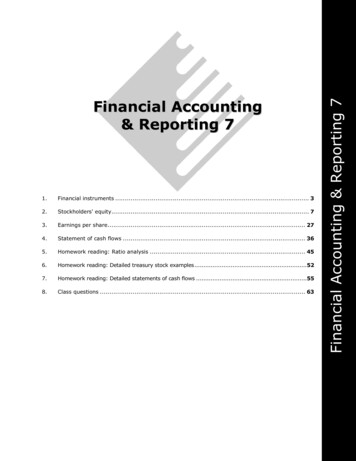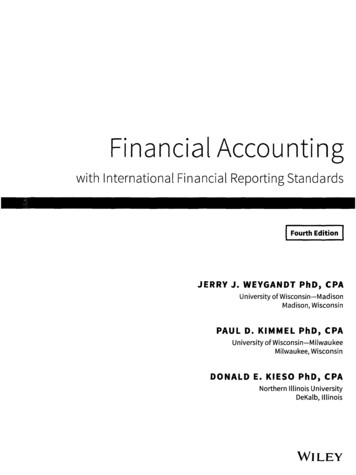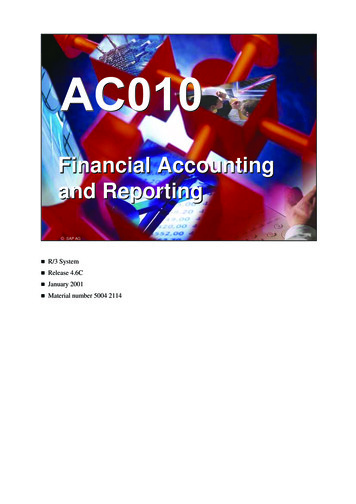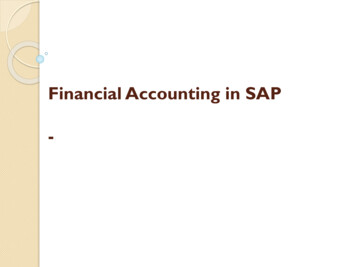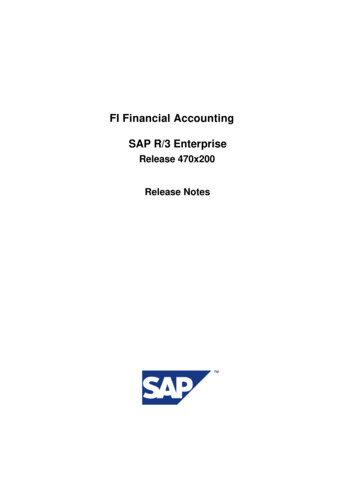
Transcription
FI Financial AccountingSAP R/3 EnterpriseRelease 470x200Release Notes
Copyright 2003 SAP AG. All rights reserved.No part of this publication may be reproduced or transmitted in any form or for any purpose without the express permissionof SAP AG. The information contained herein may be changed without prior notice.Some software products marketed by SAP AG and its distributors contain proprietary software components of other softwarevendors.Microsoft , WINDOWS , NT , EXCEL , Word , PowerPoint and SQL Server are registered trademarks ofMicrosoft Corporation.IBM , DB2 , OS/2 , DB2/6000 , Parallel Sysplex , MVS/ESA , RS/6000 , AIX , S/390 , AS/400 , OS/390 , andOS/400 are registered trademarks of IBM Corporation.ORACLE is a registered trademark of ORACLE Corporation.INFORMIX -OnLine for SAP and Informix Dynamic ServerIncorporated.TMare registered trademarks of Informix SoftwareUNIX , X/Open , OSF/1 , and Motif are registered trademarks of the Open Group.Citrix , the Citrix logo, ICA , Program Neighborhood , MetaFrame , WinFrame , VideoFrame , MultiWin and otherCitrix product names referenced herein are trademarks of Citrix Systems, Inc.HTML, DHTML, XML, XHTML are trademarks or registered trademarks of W3C , World Wide Web Consortium,Massachusetts Institute of Technology.JAVA is a registered trademark of Sun Microsystems, Inc.JAVASCRIPT is a registered trademark of Sun Microsystems, Inc., used under license for technology invented andimplemented by Netscape.SAP, SAP Logo, R/2, RIVA, R/3, SAP ArchiveLink, SAP Business Workflow, WebFlow, SAP EarlyWatch, BAPI,SAPPHIRE, Management Cockpit, mySAP.com Logo and mySAP.com are trademarks or registered trademarks of SAP AGin Germany and in several other countries all over the world. All other products mentioned are trademarks or registeredtrademarks of their respective companies.Design: SAP Communications Media
SAP SystemTable of ContentsSAP 8.1.12.8.22.8.2.12.8.2.22.8.2.32.8.2.42.8.2.5FI Financial AccountingFI-GL General Ledger AccountingFI-GL-IS Information System1111111122223333333677FI-AP Accounts PayableFI-AP-AP Basic FunctionsFI-AP-AP-CL Closing OperationsFI-AR Accounts ReceivableFI-AR-AR Basic FunctionsFI-AR-AR-CL Closing OperationsFI-BL Bank AccountingFI-BL-PT Payment TransactionsFI-BL-PT-LB LockboxPostprocessing Lockbox (enhanced)FI-AA Asset AccountingFI-AA-SVA Special valuationProperty Tax Report (Japan) (New)Post Revaluations and New Valuations (New)FI-FM Funds ManagementConsignment Process in Funds Management (New)Validity Dates for Application of Funds anin FMFI-AF Additional FunctionsFI-AF-DPC Down Payment ChainsDown payment chains (new)FI-TV Travel ManagementFI-TV-PL Travel PlanningGalileo Interface (new)FI-TV-COS Travel ExpensesInterface Deutsche Bahn Corporate Portal (BIBE) (new)Country Version for ItalySeparation Allowance Regulations of German Federal StatesSeparation Allowance Stopovers for Business TripsSubsidies for Trips Home in Separation AllExternal Stays7888999101011111212SAP AGiii
SAP System2 FIFinancial Accounting2.1 FI-GL2.1.1 FI-GL-ISGeneral Ledger AccountingInformation System2.1.1.1UseFrom SAP R/3 Enterprise Financials Extension 2.00 (EA APPL 200) you can use drilldown reporting tocreate reports on average balances (reports to display average daily balances). In particular, these reportsare required in the banking area.Previously you had to save the average balances separately in an average balance ledger and could onlycalculate the key figures year-to-date and month-to-date. Now, all you have to do is activate a day ledgerin Customizing. You can then calculate all the standard key figures (month-to-date, quarter-to-date,week-to-date, year-to-date, and so on).When you define the drilldown reports you can use several average balance key figures or severalaverage balance key figures with balance sheet key figures in one report. SAP delivers two sampledrilldownreports ADBREPORT-1 and ADBREPORT-2 for calculating average balances. For moreinformation, see SAP note 599692.Effects on CustomizingIn order to be able to create reports for average balances, you have to activate a day ledger in the SpecialPurpose Ledger (FI-SL) (an FI-SL totals table with 366 periods that contains the original postings). TheIMG activity for activating the FI-SL totals table is in Customizing for Financial Accounting underSpecial Purpose Ledger - Information System - Drilldown Reporting - Use DrilldownReporting - Activate Drilldown Reporting for FI-SL Tables.2.2 FI-APAccounts Payable2.2.1 FI-AP-APBasic Functions2.2.1.1 FI-AP-AP-CLClosing Operations2.2.1.1.1UseFrom SAP R/3 Enterprise Financials Extension 2.00 (EA APPL200), as preparation for the consolidationSAP AG1
SAP Systemyou can use this function to ensure the following for postings of receivables and payables within thegroup:oCompletenessoCorrect amount and currencyoPosting to accounts indicated as trading partnersThe system finds items for which there is no opposing entry in the partner company.It also finds items that are indicated as cleared in one company, but that are still open in the othercompany.It recognizes items as belonging together if the reconciliation criterion (as standard the reference) isidentical and the amounts and currencies agree in both companies.If a criterion does not match, the items are not reconciled and are displayed in the manual reconciliation.In contrast to RFICRCOO, the program can also reconcile items in different clients or R/3 systems.The user can also assign items locally, without changing the documents.2.3 FI-ARAccounts Receivable2.3.1 FI-AR-ARBasic Functions2.3.1.1 FI-AR-AR-CLClosing Operations2.3.1.1.1UseFrom SAP R/3 Enterprise Financials Extension 2.00 (EA APPL200), as preparation for the consolidationyou can use this function to ensure the following for postings of receivables and payables within thegroup:oCompletenessoCorrect amount and currencyoPosting to accounts indicated as trading partnersThe system finds items for which there is no opposing entry in the partner company.It also finds items that are indicated as cleared in one company, but that are still open in the othercompany.It recognizes items as belonging together if the reconciliation criterion (as standard the reference) isidentical and the amounts and currencies agree in both companies.If a criterion does not match, the items are not reconciled and are displayed in the manual reconciliation.In contrast to RFICRCOO, the program can also reconcile items in different clients or R/3 systems.SAP AG2
SAP SystemThe user can also assign items locally, without changing the documents.2.4 FI-BLBank Accounting2.4.1 FI-BL-PTPayment Transactions2.4.1.1 FI-BL-PT-LBLockbox2.4.1.1.1 Postprocessing Lockbox (enhanced)UseAs of SAP R/3 Enterprise Financials Extension 2.0 (EA APPL 200) you can create Dispute Cases forchecks when postprocessing the lockbox. The postprocessing of the lockbox has been integrated in thenew bank statement postprocessing for this purpose.Additional new functions:oSimultaneous display of several lockboxes and quick navigation between them.oChange the customer in the payment advice note headeroFree selection of customers, G/L accounts or vendorsoSimultaneous posting of several checksTo access lockbox postprocessing, go to the SAP Easy Access screen and choose FinancialAccounting - Banks - Incomings - Lockbox - Postprocessing (or Reprocess).Effects on System AdministrationTo create dispute cases from the postprocessing of the lockbox you require the component SAP DisputeManagement.See alsoYou can find additional information on the lockbox in the SAP Library under Accounting - FinancialAccounting (FI) - Bank Accounting (FI-BL) - Payment Transactions - Lockbox.For additional information on Dispute Management, visit the SAP Help Portal in the Internet under theaddress help.sap.com - SAP Cross Industry Solutions - mySAP Financials - SAP FinancialSupply Chain Management - SAP Dispute Management.2.5 FI-AA2.5.1 FI-AA-SVAAsset AccountingSpecial valuationSAP AG3
SAP System2.5.1.1 Property Tax Report (Japan) (New)UseAs of SAP R/3 Enterprise 47 200, companies in Japan can prepare property tax declarations using anew report, the Property Tax Report. This replaces the Statement of Net Assets report.The new report offers a number of functions that were not available in the old report. For example:oTax accountants can use it to prepare tax declarations that handle additional depreciation and thatare formatted exactly as required by each tax office.oCost center managers can use it to forecast how much property tax their cost center will have to pay.Effects on Existing DataBefore you execute the program for the first time, you must:oProvide the report with various data from last year's property tax declarationoPost asset transactions manually (depending on when you go live)oMaintain the asset master recordsThese activities are described in more detail in the following.NoteSAP Japan provides a number of data migration programs to help you go live with the report. For moreinformation, see SAP Note 616975.Opening Values for Tax DeclarationBefore you run the report for the first time, you must provide it with various data from last year'sproperty tax declaration, for example, each asset's tax book value and tax evaluation amount. It needs thisinformation to be able to prepare this year's property tax declarationThat means that you have to fill out the following fields in the report's results table(IDFIAA JP RESULT):FieldMANDTBUKRSANLN1ANLN2NUMC DECL YEARNUMC14 LOG SEC(YYYYMMDDHHMMSS)NUMC14 STORE SECCURR APC TOTALdeclaration periodCURR TAX BVLContentsClientCompany codeMain asset numberAsset subnumberTax declaration yearTime when data was saved in results tableSequential number of recordTotal acquisition and production costs at end of taxTax book valueSAP AG4
SAP SystemCURR TAX EVATax evaluation amountWe recommend that you use the migration program provided by SAP Japan. For more information, seethe Note mentioned above.Posting Asset Transactions ManuallyIn order to calculate each asset's taxable value, the report reads all of the data from the asset transactionsthat you have posted over the course of the tax declaration year. For example, the 2006 tax declarationcovers all of the asset transactions that occurred from 2 January 2005 through 1 January 2006.Therefore, if you go live with Asset Accounting (FI-AA) partway through the tax declaration year, youmust also post the asset transactions from the first part of the tax declaration year in the system.For example, assume you intend to go live on 1 November 2005. By 1 November you have migrated allof your legacy data, including the data described above. As of that date, your accounting clerks post allasset transactions in the SAP R/3. However, when you come to prepare the 2006 property tax declaration,it also requires all the asset transaction data from 2 January through 31 October 2005. You therefore haveto ensure that all this data is available in your system as well.That means that you have to fill the fields in the tables listed below. Again, we recommend that you usethe migration programs provided by SAP Japan.In the table ANEK (asset transaction header), fill out the following nsaction codeYesReversal document numberNoReversal document fiscal yearNoQuantityYesBase unit of measureYesAsset number sending/receiving asset in transferSubnumber sending/receiving asset in transferReference document number*YesNumber of line item within accounting documentAsset value dateYesIndicator: Post proportional values automatically*Reference procedure*YesReference organizational units*YesYesYesNoYes*In the event of transfers from one asset to another, these values in the sending asset and the receivingasset must be identical.In the table ANEP (asset line items), fill out the following fields:FieldMANDTBUKRSANLN1ContentsClientCompany CodeMain asset numberObligatory?YesYesYesSAP AG5
SAP RLNSANdocumentsAsset subnumberYesFiscal yearYesSequence number of asset line items in fiscal year Yes*Real depreciation areaYesAccounting document numberYes**Number of line item within accounting document If availableAsset value dateYesAsset transaction typeYesAmount postedYesSequence number of reversed asset line items Yes, but only in reversal*After you have filled this table and ANEK, find the highest number in this field for each asset and enterit in the field ANLH-LANEP before you make the first posting on 1 April.**In the event of transfers from one asset to another, these values in the sending asset and the receivingasset must be identical.Asset Master MaintenanceThere are a number of fields in the asset master that you need to fill out. There are also new procedures tofollow in some asset transactions. For details, see the SAP Library documentation mentioned below.Effects on CustomizingMake the settings in the IMG activity Make Settings for Property Tax Report, and implement theBusiness Add-Ins that you need. The Add-Ins and the IMG activity are located in Customizing forFinancial Accounting (FI) under Asset Accounting - Information System - Property Tax Report(Japan).Again, SAP Japan provides some sample implementations for some of the Add-Ins.See alsoSAP Library - SAP R/3 Enterprise Application Components - Logistics - Country Versions - Asia-Pacific - Japan - Financial Accounting (FI) - Asset Accounting (FI-AA) - Property Tax2.5.1.2 Post Revaluations and New Valuations (New)UseAs of R/3 Enterprise Extension Set 2.0, you can use the new Post Revaluations and New Valuationsreport to revaluate assets in accordance with the Australian Accounting Standards AAS10
2.4.1.1 FI-BL-PT-LB Lockbox 3 2.4.1.1.1 Postprocessing Lockbox (enhanced) 3 2.5 FI-AA Asset Accounting 3 2.5.1 FI-AA-SVA Special valuation 3 2.5.1.1 Property Tax Report (Japan) (New) 3 2.5.1.2 Post Revaluations and New Valuations (New) 6 2.6 FI-FM Funds Management 7 2.6.1 Consignment Process in Funds Management (New) 7 2.6.2 Validity Dates for Application of Funds an in FM 7 2.7





